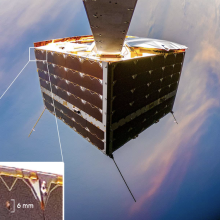A Japanese spacecraft has made a daring approach to a discarded rocket in Earth's orbit.
The mission — undertaken by the satellite technology company Astroscale — intends to eventually remove the 36-foot-long spent rocket stage, but has first tested its ability to rendezvous with the problematic object (one of 27,000 space junk objects larger than 10 centimeters in orbit).
The pioneering space endeavor is called Active Debris Removal by Astroscale-Japan, or ADRAS-J.
"Ending 2024 with a historic approach!" Astroscale posted online. "Our ADRAS-J mission has achieved the closest ever approach by a commercial company to space debris, reaching just 15 meters [almost 50 feet] from a rocket upper stage."
This rocket stage, weighing three tons, is the upper part of the Japanese Space Exploration Agency's (JAXA) H2A rocket, which launched the Earth observation GOSAT satellite in 2009. The greater space debris removal mission is part of JAXA's "Commercial Removal of Debris Demonstration" project, which seeks a proven way to remove problematic space junk from orbit.
ADRAS-J previously flew around the hunk of discarded metal, capturing imagery and gathering data on the rocket's condition and motion. This latest and closest endeavor, achieved on Nov. 30, demonstrated the spacecraft's ability to operate precisely in such close range to the derelict rocket, a requirement for the future capture of the unwieldy, large object. An accident between large objects, moving at thousands of miles per hour, isn't acceptable: It would exacerbate the problem.
To complete this close-proximity endeavor, ADRAS-J moved from behind the rocket, approaching in a straight line from 50 meters (164 feet) away. The craft then stopped at 15 meters out from an even closer point. This mission had successes, but as is the norm for novel space missions, it didn't go entirely as planned. The craft didn't reach the point where a follow-up mission will actually capture the rocket stage.
"ADRAS-J successfully maintained this position until an autonomous abort was triggered by the onboard collision avoidance system due to an unexpected relative attitude anomaly with the upper stage," the company said. "The spacecraft safely maneuvered away from the debris as designed before reaching the Capture Initiation Point. Astroscale Japan is currently investigating the cause of the abort."
The space imaging and technology company HEO captured a view of the ADRAS-J spacecraft closing within 50 meters of the upper stage during this latest approach.
Tweet may have been deleted
Additionally, the conceptual rendering below shows what this close approach likely looked like, and Astroscale has released previous images of the actual space junk target (also shown below).


The $82 million follow-up mission, ADRAS-J2, is expected to launch in 2028.
That spacecraft, currently under construction, will bring the rocket stage down to a lower orbit using a robotic arm. Eventually, it will largely burn up in Earth's atmosphere. In the future, the hope among spacefaring nations and commercial space interests is to keep low Earth orbit (LEO) largely clear of threatening space debris — especially inert craft that can't maneuver on their own.
"LEO is an orbital space junk yard," NASA explains. "There are millions of pieces of space junk flying in LEO. Most orbital debris comprises human-generated objects, such as pieces of spacecraft, tiny flecks of paint from a spacecraft, parts of rockets, satellites that are no longer working, or explosions of objects in orbit flying around in space at high speeds."
Topics NASA















